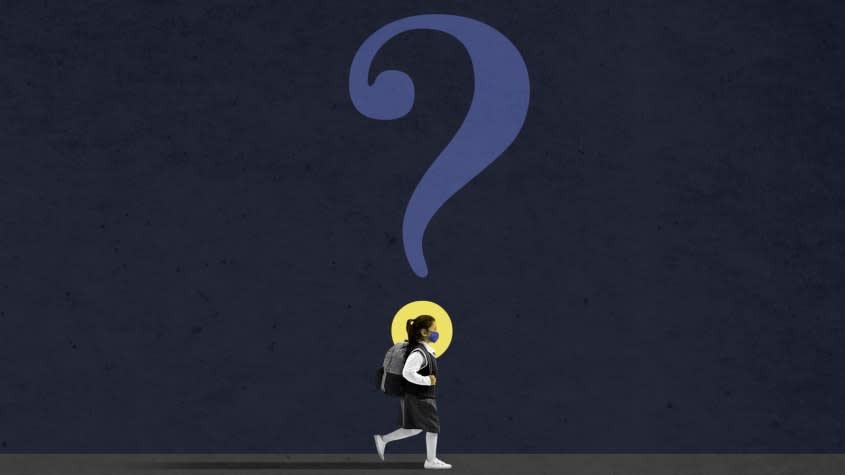Why pandemic parenting is harder than the data suggests it should be

My family recently moved halfway across the country, and we decided to try a local daycare in our new city. The place we picked had a lot to recommend it, and by happy chance our twins enrolled mere days after the state mask mandate lifted. Several weeks later, however, when new federal mask guidance dropped, the daycare voluntarily revived its mask requirement for kids 2 and up. We withdrew our kids from the facility because, like the World Health Organization, we don't think toddlers should wear masks.
You may judge our decision a groundless caution and the daycare's policy an eminently reasonable call — or you might reverse those judgments, as I do. Gallup poll results published Tuesday show just over half of American parents of K-12 students believe unvaccinated children should go to school masked this fall, and that sort of disagreement is raging all over as our third COVID-affected schoolyear begins: What's an acceptable level of pandemic risk for children? What degree of risk tolerance makes you a Bad Parent? How should we balance the direct risk of the disease itself with the many indirect, less measurable, yet still very real risks incurred by upending children's lives?
These questions are uniquely tricky, I think, not because COVID-19's risk to children is uniquely high or — at this point in the pandemic — because the information about that risk is uniquely muddled. They're primarily tricky because they're so new, and that means we have to actually think them through.
Parents make judgment calls about risk every day. Should your kid climb a tree? Learn to swim? Ride in a car? Try peanut butter? Taste your beer? Keep a playdate while a stomach bug is going around? Sleep over at a friend's house? We might not always frame them this way, but each one of these questions is a risk assessment. We usually do a decent job making such calls, and we agree on a lot, even across cultural rifts like the helicopter parent vs. free-range kids divide.
In this subconscious decision mode, parents constantly expose our children to risk, weighing potential costs against attainable benefits, day in and day out, typically with little deliberation or worry. There's no practical alternative — you have to make a snap decision when the question arrives: "Mom, can I ... ?"
That's feasible because most of these questions are familiar, and familiarity gives us a working knowledge on which to base our calls. I've climbed trees and drank beer and gone to sleepovers, and I know firsthand the advantages of driving a car. I put my children in our car without a second thought, though vehicle accidents are the second-highest cause of children's deaths in the United States, because I believe (as almost everyone does) the benefits exceed the risks. I never considered doing otherwise. I certainly didn't agonize over the decision the way many Americans are now agonizing over the best choices for kids and COVID-19.
That difference isn't because COVID-19 is riskier or the risk more uncertain. For children, the opposite is true, as we've known for some time: The youth are enormously protected against this illness. "Serious forms of COVID are so rare in children that a few countries with better recent COVID track records than the U.S. — like Britain, Germany and Israel — may not even officially urge vaccinations for most children," The New York Times reported in June. "The decision will be up to individual parents." An unvaccinated 30-year-old (let alone a child) has a lower risk of death from COVID-19 than a vaccinated 60-year-old:
As parenting statistician Emily Oster put it in The Atlantic, "your unvaccinated kid is like a vaccinated grandma," for simply "being a child is a really great vaccine." For adults, for example, COVID-19 is far deadlier than the flu:
But for children, according to the Centers for Disease Control (CDC), the flu is the graver risk for death and illness serious enough to require hospitalization alike. Cars, drowning, and cancer are also greater risks to children's lives than COVID-19:
For parents concerned about "long COVID" (protected illness in which symptoms linger for weeks or months after the acute infection), the data is more limited but similarly encouraging for risk calculations. One "recent study in pre-print, looking at [National Health Service] data in the U.K., found that among more than one million patients diagnosed with COVID, only 3,000 registered long COVID — well under 1 percent," reports David Wallace-Wells at New York magazine. "We don't yet have anything like that scale of study considering similar cases in American kids, but a subset of long-COVID research linking the severity of disease to the likelihood of enduring symptoms implies that the risk may be considerably smaller in children than in the population at large."
This is all pretty straightforward and well-established, a year and a half after the pandemic reached the States. But it still feels strange and new, and that complicates the conversation around kids and risk enormously.
We can't rely on long familiarity, nor are many of us good at processing all the math being thrown our way, nor can we point to universally accepted benefits that make the risk worthwhile. Everyone knows cars are useful. Before last year, most of us had never considered whether and to what extent it is important for a 7-year-old to see his teacher's entire face. We have to think about it all deliberately and repeatedly as conditions and mandates evolve, with numbers and headlines and accusations all swirling around.
There's no familiar shortcut. There's no longstanding consensus. We can't make the usual subconscious call.
You may also like
Why Tom Brady's 'gentle' roast of Trump at Biden's White House was actually 'deeply vicious'
Israeli data suggest infected, vaccinated individuals have low chance of spreading COVID-19
A tie for gold led to one of the most joyful celebrations at the 2020 Olympics
